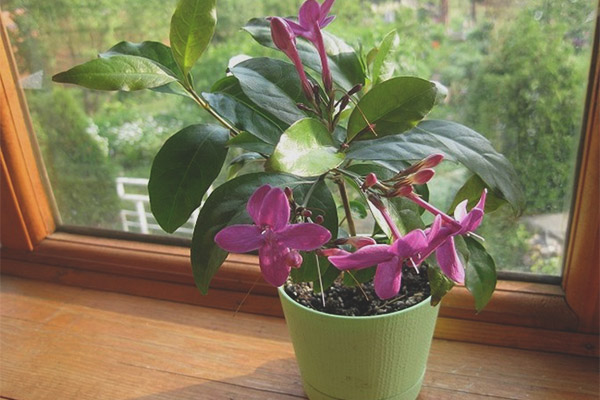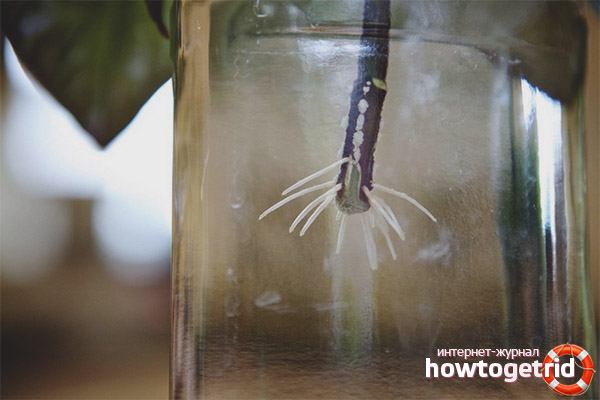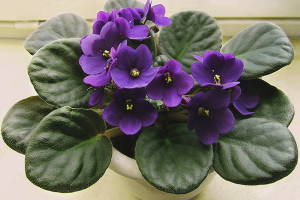The content of the article
Psevdrantemum flower growers prefer for the fact that the plant has a very unusual foliage, and you can decorate any room beautifully. This tropical plant belongs to the Aktanov family and is an erect shrub crop.
Leaves that do not exceed 15 centimeters in length, depending on the type of pseudorantemum, may have the most unexpected form:
- in the form of an ellipse;
- lanceolate;
- obovate.
On examination, it turns out that dark green leaves, on which violet or purple inclusions are noticeable, appear to be covered with wax, and the surface of the plate is wrinkled, with tubercles.
Very tender inflorescences from the plant. Usually they are apical, with pale pink, white or purple petals.
Who is not familiar with the features of the plant, will be surprised by its unusual behavior.A special “box” is formed in a pseuda ranstemum, in which seeds ripen. When the time comes, it opens up too stim, and shoots seeds. For a plant it is a very effective way to continue its kind. At home, the plant is carefully looked after, adhering to some rules.
Illumination and the right place
Bright light plant likes, but prefers to take it in a scattered form. The place is usually assigned to it on the western or eastern side, but if there is no way out, and one has to contain a pseudorantum on the window of the southern part, in the afternoon it is necessary to create a darkening in this place. The state of the leaves depends on the sun rays:
- Too strong sunbaths cause leaf burns, they become intensely red, and the plant ceases to grow.
- With a lack of ultraviolet rays, the original spots on the plant disappear.
In winter, bright lighting is also required, so it is recommended to create it additionally with the help of fluorescent lights.
Fact! The plant has a forced rest time, which lasts approximately from October to March.
The plant is very demanding for the temperature regime, it wants to be constantly warm, and it is very painful for drops and drafts: the lower leaves then begin to fall off. That is why in the summer flower growers ensure that the temperature in the room is 22-25 degrees, and in winter it does not fall below the 20-degree mark.
There is another requirement for a room that contains a pseudorantemum. There should be increased humidity. At the same time, the flower will still have to be sprayed, regardless of the season, and this procedure is most important during the period of rapid growth and during intense heat.
It is also necessary to provide the plant with moisture in winter, when artificial heating dries the air. To provide the plant with moisture this season, you need:
- periodically wipe the leaves with a damp cloth;
- additionally put moistened moss or pebbles in the tray.
The tropical nature of the plant is manifested in the fact that it is very fond of moisture. So, always waiting for abundant watering after the topsoil dries. And this happens quite quickly, because the liquid through the leaves evaporates intensively.It is impossible to overdry the soil, as the plant will begin to ache, wither, shed leaves. But too much water will cause the root system to rot.
To maintain the plants need fertilizer and fertilizing!
It will take pseudoranthemum fertilizer in spring and summer. In cold weather, the plant is excellent without them. It is better to purchase those in which the potassium content is increased. It is with his help that the leaves will have a beautiful color. The selected substrate can be not only neutral, it is permissible that it is slightly acid.
When the soil is loose and nutritious, moisture and air flow well through it, the plant will be healthy.
How to transplant pseudoranthemum?
Only young plants require transplantation. For adults, this procedure will be needed only in the most necessary cases. Florists are considered to be the best mixture for a plant that contains such ingredients:
- peat - 1 part;
- sand - 1 part;
- perlite - 1 part;
- leaf earth - 2 parts.
Perlite is used in order for the plant to have a moisture regulator, the structure of the soil has improved, so that it does not condense, there are moisture and air exchange.This substance may remove excess water from the soil, and when it is lacking, return it. At the bottom of the pot must be high-quality drainage.
Fertilizers will need a universal organic plant in small concentrations. They are best made during the active growing season during watering. The desired frequency is once a month and a half.
The pseudo-aranthemum is distinguished by its rapid growth, so during a transplant you need to pick up a pot that will be several times larger than the previous one. Tight capacity will cause a response: the plant will rebel, dropping leaves. The root system is also rapidly increasing, so the roots should be shortened during transplanting.
Proper pruning
When the pseudorantemum grows, the bottom sheets of it fall off and the trunks do not look very nice, which is why a plant needs to be groomed and neat, it needs regular pinching and pruning of the branches — you need to achieve more branching with these methods. Side shoots are recommended to press to the ground with a cord, tying the cord itself around the pot to get a beautiful shape.Because the growth of the side shoots occurs only at the top.
Breeding
Reproduction occurs in the spring with the help of grassy cuttings due to the fact that at home pseudoratemum almost does not bloom. They can be rooted:
- In the substrate (its temperature should be from +25 degrees, 70% humidity) - the cuttings are covered with glass and it is not removed until the cuttings are rooted. For rooting applied solution Epin.
- In water (temperature from +25 to +29 degrees).
After a month, the young plants will get stronger and be ready for transplanting into ordinary pots. Caring for them is normal.
Diseases and pests
Diseases, their causes and the fight against them:
- Root rot (excessive watering) - the plant comes from the pot, dries out a couple of days and shakes off the ground so that it is convenient to cut the affected areas, then the plant is planted back into the ground.
- Spider mites (dry air) - the affected leaves come off, the plant is completely washed under water. The pot and pan are rinsed in hot water. After the plant has been planted back, it is covered with a pot along with a pot so that there is no access to air for 2-3 days.
- Mealybug (after themselves leaving honey dew on the plant, on which mold then sticks), scale insects, whiteflies (poor-quality care is the most common cause of many diseases in the plant). The pots are washed with a special disinfectant. The roots of the plant are washed, placed in a solution of any insecticide. The plant is transplanted into a new fresh wet soil.
The difficulties from improper growing can be the following:
- Falling leaves and their yellowing can be caused by excessive watering and low humidity, due to which the roots dry up. Or the reason may be a lack of moisture in the air.
- Brown spots on the leaves and dry tips of the leaves - from an oversupply of natural light or from dry air.












To send